|
On Two Fronts
One Million Browning Machine Guns
AC Spark
Plug Division of GMC in World War Two
Flint, MI
1908-1988
Rest in Peace
This page updated
12-10-2024.

This 12x8 foot sign was built into the
overpass at the original AC Spark Plug plant on Industrial Avenue in
1909. Currently it is on display at the Sloan Museum in Flint, MI
after being donated to the museum by General Motors. Author's
photo.

Author's photo.

This is the original Champion spark plug
plant on the southeast corner of Industrial Avenue and Harriet Street in Flint, MI
after the addition of 18,000 square feet in 1915. Champion came to
Flint in 1908 at the request of Billy Durant, to supply spark plugs to
the fledgling local auto industry. Originally, Champion was
located in a Buick building, but then built the one shown above in 1912.
The Industrial Avenue plant as originally
built was 33,000 square feet. The addition of a second building at
the site in 1915 added 18,000 square feet. In 1918 more buildings
were added bringing the total square footage to 88,000 square feet.

This photo shows the AC Spark Plug plant on
Industrial Avenue, at a later date after much expansion. The
original structure is in the center portion on the left-hand side or
west side of the photo. Expansions were built to the north and
south of the original structure, and also on the east side of Industrial
Avenue. During World War Two this was AC Spark Plug's main
manufacturing plant. Many of the products it supplied for the war
effort were built here. In 1975 it was closed and then razed.

This is an early photo of the AC Spark Plug
plant on Dort Highway. J. Dallas Dort originally built the plant
in 1915 to produce automobiles. AC Spark Plug purchased the
plant in 1925 after the Dort Motor Company went out of business in 1924,
and
before becoming part of General Motors in 1929.

The Dort Highway plant, looking northeast from across Dort Highway.
Early Product Development at AC Spark Plug:
The name of the division is AC Spark Plug but it made more than spark plugs. In 1919 AC Spark
Plug added speedometers to its product line. In 1925 it added air
cleaners, and in 1926 oil filters and gas filters started coming off its
assembly lines. These were followed in 1927 by mechanical fuel
pumps, ammeters, oil and temperature gauges, and tachometers. In
1928 the division began the manufacture of complete instrument panels
and crankcase breathers. Fast forward to 1975 and past many other
new products, and AC Spark Plug Division began producing the catalytic
converters that were installed on all General Motors passenger cars and
some light trucks. New products were introduced during its entire
life cycle. AC Spark Plug was just more than a spark plug
manufacturer.

The AC Spark Plug Division of General Motors
Flint, MI won the Army-Navy "E" Award five times.
The original award was presented on September 2, 1942, and the first
star was added in June 1943. The dates of the remaining three
stars are unknown.
The AC Spark Plug Division of General Motors Ionia, MI Plant won the
Army-Navy "E" Award two times. This was a Fisher Body
Plant loaned to AC for the manufacture of spark plugs.
.

The original "E" flag at AC Spark Plug in Flint, MI.
AC
Spark Plug Division of General Motors World War Two Products:
The Flint, MI operation had $270,314,000 in major contracts during World
War Two. Its Ionia, MI plant had $17,203,000 in major contracts
for the war effort.
Air Cleaners, Air Cleaner Replacement Elements, Aircraft Coolant
Pressure Relief Valves, Sperry Automatic Pilots, Bombsights, Cable
Terminal Connectors, Carbon Stack Insulators, Carburetor Intake
Silencers and Air Cleaners, Crankcase Breathers, Crankcase Ventilating
Valves, Die Castings, Diesel Engine Intake Silencers, Electric Pressure
and Vacuum Pumps, Engine Bearings for Aircraft, Tanks, and Trucks,
Firing Pins for Anti-Aircraft Shells (Should this be for Anti-Aircraft
Guns?), Flame Arrestors, Flexible Shafts and Cables, Fuel Pumps
-Electrical and Mechanical, Fuel and Vacuum Pumps, Fuel Pump Repair
Kits, Gas Tank Pressure Caps, Gasoline Strainers, Ignition Cable
Terminals, Instrument Panels for Tanks, Armored Cars, Trucks, and Marine
Craft, (containing: Ammeters, Fuel Gauges, Indicator Lights, Oil
Indicator Switches, Oil Pressure Gauges, Speedometers, Tachometers,
Water Temperature Gauges, Voltmeters), Machine Guns - Browning .50
Caliber, Oil Filters - Lubricating and Fuel, Oil Filter Replacement
Elements, Oil Temperature Gauges, Oxygen Pressure Gauges, Radiator
Pressure Caps, Shell Magazines, Spark Plugs - Automotive and Aircraft,
Spark Plug Cleaners, Spark Plug Gaping Tools, Speedometers Drive
Adaptors, and Torpedo Directors.
Author's Note: The above list
comes from the October 1943 AC Spark Plug publication "On Two Fronts."
There were almost two years left of World War Two. AC Spark
Plug manufactured other products not listed above because they were developed as
the war progressed. One such example is the K-14 Gun Sight documented
below.

The signature product of the AC Spark Plug
Division of General Motors during World War Two was aircraft spark plugs. While
AC Spark Plug made a wide variety of goods for the military during the
war,
it made millions of aircraft spark plugs, as both aircraft production and
air combat missions increased. Demand was so great that AC Spark
Plug set up spark plug manufacturing in a borrowed Fisher Body plant in
Ionia, MI. Author's photo from the Michigan Military Technical and
Historical Society.

Of the 295,959 aircraft built by American
manufacturers during World War Two, 7,546 were TBM torpedo bombers
constructed by the Eastern Aircraft Division of General Motors at
Trenton, NJ. The TBM was powered by a Wright R-2600 radial engine
with fourteen cylinders, each with two spark plugs. After a navy
squadron of twelve TBMs returned from a combat mission, all of the spark
plugs were replaced. Even though there were two sparkplugs per
cylinder, no pilot wanted a cylinder to start missing over the water, or
when full power was needed in combat. This was common practice throughout the war
by all aviation combat units. Aviation spark plugs were consumed
at a prestigious rate during the war! Author's photo from the
Liberty Aviation Museum in Port Clinton, OH.
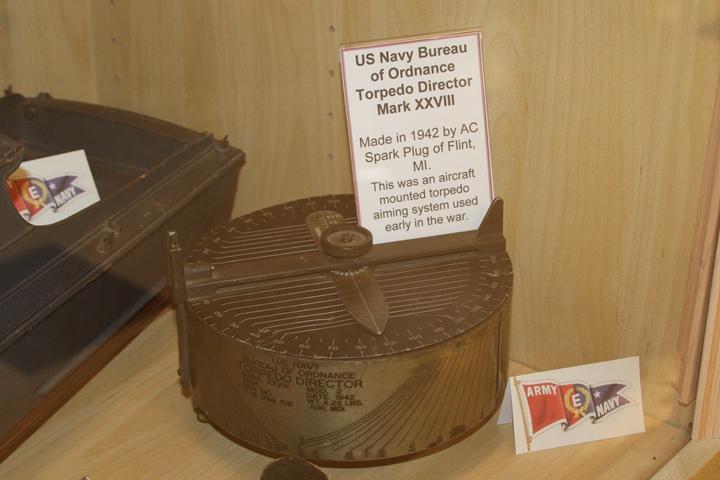
Pages 4 and 16 of "On Two Fronts" note that
AC Spark Plug built torpedo directors which were used in the Battle of
Midway. This very rare example of the AC Spark Plug-built torpedo
director is also on display at the Michigan Military Technical and
Historical Society. Author's photo added 4-19-2021.

Author's photo added 4-19-2021.

Author's photo added 4-19-2021.

AC Spark Plug had two contracts for pressure
vacuum pumps from the USAAF during World War Two. The first one
was contract number 20017-AC-995 for $198,000. The second was
contract number 33038-AC-5807 for $588,000. This one is part of
the collection of Mr. Lee Smithson. Photo courtesy of Lee Smithson
added 12-10-2024.

Photo courtesy of Lee Smithson added
12-10-2024.

Photo courtesy of Lee Smithson added
12-10-2024.

Photo courtesy of Lee Smithson added
12-10-2024.
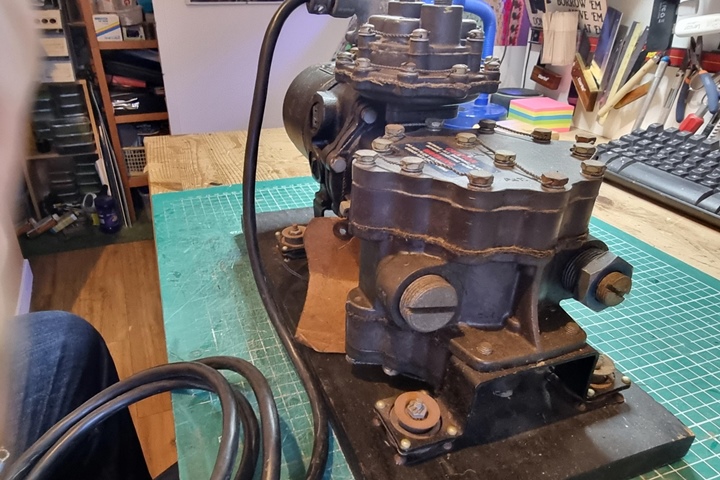
Photo courtesy of Lee Smithson added
12-10-2024.

Typical of a General Motors Division, when
AC Spark Plug required a motor for the pressure vacuum pump, it obtained
the motor from another GM Division. This kept the business within
the corporation. Photo courtesy of Lee Smithson added 12-10-2024.
Auto-pilots and Bombsights:
During World War Two, Sperry
Corporation was a producer of bomb sights and auto-pilots for military
aircraft. With the attack on Pearl Harbor in December 1941, the
demand for these products exceeded the capability of Sperry to provide
them. At the request of the U.S. government, AC Spark Plug took on
the task of also building Sperry auto-pilots and bombsights for American
aircraft. Below are several of the Sperry components AC
Spark Plug built during WWII. More information on these products
can be found in "On Two Fronts" published by AC Spark Plug in October
1943. There are links to this publication at the top and bottom of
this page.

On display at the Sloan Museum in Flint, MI
is an AC Spark Plug built auto-pilot on the left, and a mechanical analog
bombsight computer on the right. Author's photo.

Author's photo.

Author's photo.

The data plate on the bombsight computer
indicates it is the vertical gyro part number 644841, built
under license by AC Spark Plug. Author's photo.

Author's photo.

This AC Spark Plug Division-built Sperry
vertical gyro is on display at the Tri-State Warbird Museum in Batavia,
OH. The cover has been lifted to show the internal workings of the
unit. Author's photo.

The gyroscope can be at the rear of the
unit. Author's photo.

Author's photo.

The component on the left of the display is
the vertical gyro for the Sperry auto-pilot. Author's photo.

The direction gyro is part number 656029.
Author's photo.

A-C Spark Plug built this Sperry T-1-A
bombsight computer which was also used with the sighting head shown.
It was photographed as part of the special International Radio
Corporation/Argus display at the Yankee Air Museum in Belleview, MI.
Author's photo added 2-10-2019.
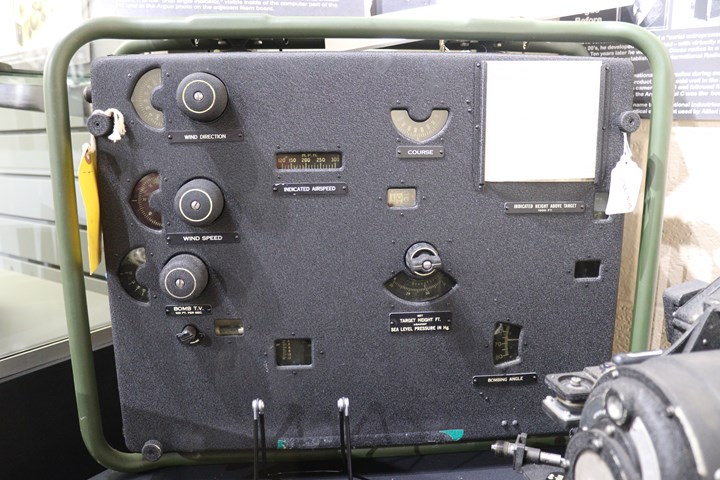
Author's photo added 2-10-2019.

Author's photo added 2-10-2019.

This T-1-A Bombsight Computer was built in
1943 and is Serial Number 43-19718. Author's photo added
2-10-2019.

Author's photo added 2-10-2019.

On display at the Michigan Military
Technical and Historical Society is this Sperry A-5 auto-pilot amplifier
that was supposed to be installed in Ford built B-24.
Unfortunately it did not meet the requirements of the Ford incoming
inspection and was rejected. On the positive side, if it had not
been rejected, it would not have been saved for eventual display at the
museum. Author's photo

AC Spark Plug was not a subsidiary of
General Motors. It was a Division of GM.
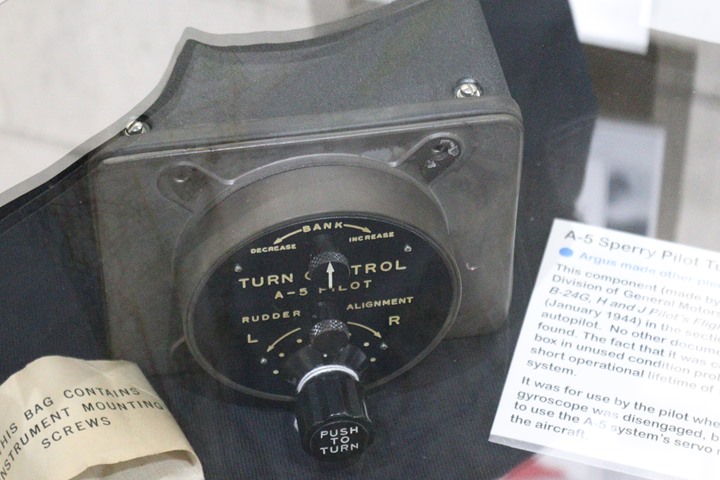
This Sperry A-5 Pilot's Turn Control was
also built by A-C Spark Plug. It was photographed as part of the
special International Radio Corporation/Argus display at the Yankee Air
Museum in Belleview, MI. Author's photo added 2-10-2019.
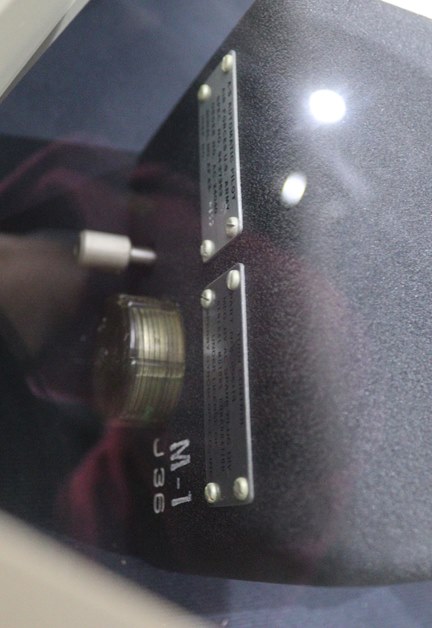
Author's photo added 2-10-2019.

Author's photo added 2-10-2019.

This Sperry A-5 Navigator's Turn Control was
also on display as part of the special International Radio
Corporation/Argus display at the Yankee Air Museum in Belleview, MI.
Author's photo added 2-10-2019.

Author's photo added 2-10-2019.
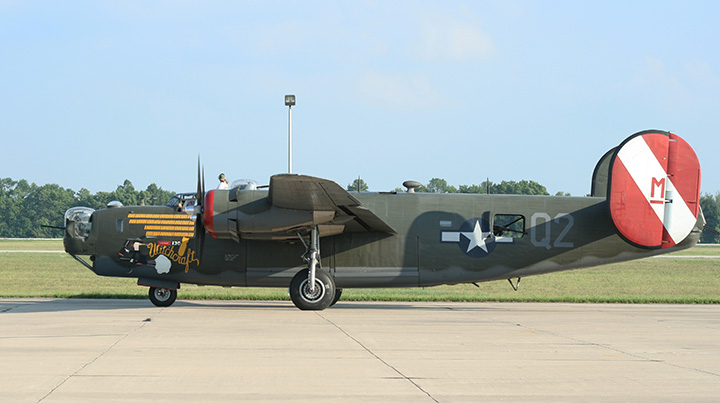
This is a B-24 like the ones Ford built at Willow Run, MI. The B-24 was
also built in California, Oklahoma, and Texas. AC Spark Plug-built
Sperry components may have also been shipped to these locations.
Author's photo.

"On Two Fronts" discusses AC Spark Plug
building a bombsight. But it is very generic and does not state
much else because bombsights during World War Two were top secret
devices. There were two advanced bombsights used by the United
States military; the Norden and the Sperry. While the Norden
was the most famous, and the better of the two bombsights, the Sperry
was also used in many bombers during the war. From what "On Two
Fronts" says, it was also given to American allies during the war.
The Norden was only used by American bombers. AC Spark Plug no
doubt built the Sperry version, due to its relationship with the company.
This one was photographed by the author at the National Museum of the
United States Air Force in Dayton, OH.

Author's photo.
K-14 Series Gun Sights: AC Spark
Plug Division was the sole supplier of K-14s gyro-computing gun sights
during World War Two. These sights were a post-1943 development, and not included in the
October 1943 "On Two Fronts." The Division produced the A, B, and C
models of the K-14. The K-14B series gun sights were introduced in
September 1944 for P-51D Mustang fighters, making K-14B the most modern of the
gun sights utilized by the US Army Air Forces in World War Two. K-14B gun
sights were used on American fighters up through the 1950s, even on some
early jet aircraft. It was the ultimate in World War Two American
gun sights.
Bendix made the naval version of the K-14
during World War Two. After the war A-C Spark Plug and Bendix
stopped making the K-14. Eastman Kodak in Rochester, NY took over
the business of both companies and
continued the production or remanufactured the K-14 series for the early
post war period.
|
Information Found on AC Spark Plug
K-14 Series Gun Sight Data Plates via Internet Images |
|
Type Gun Sight |
Drawing Number |
Serial Numbers of Examples Found |
Contract Number |
Spec. Number |
Manufacturer |
|
K-14A |
5581001 |
2405 |
AC 1898 |
C-24955 |
AC Spark Plug Division, General Motors Corp, Flint Mich. |
|
K-14B |
5581622 |
0043 |
AC-541 |
R-24977 |
AC Spark Plug Division, General Motors Corp, Flint Mich. |
|
K-14C |
5600108 |
AF858 |
33(038)27956 |
Mil-S-6147 |
AC Spark Plug Division, General Motors Corp, Flint Mich. |
Below is an AC Spark Plug-manufactured K-14B
on display at the Sloan Museum in Flint, MI.

Author's photo.

Author's photo.

Author's photo.
K-14B Gun Sight at the Cradle of Aviation
Museum on Long Island, NY, May 2018:
Walking up to this display at the Cradle of
Aviation Museum and understanding immediately that I had found a
precious piece of AC Spark Plug history in New York, would not have been
possible without my trip to the Sloan Museum two months earlier in
March. Previously, I was totally unaware that AC Spark Plug
made gun sights for fighter aircraft in World War Two. Without the
knowledge gained in March, I would have walked right by this display,
not knowing that the K-14B Gun Sight was used on late model P-47s.

This P-47 instrument panel on display at the
Cradle of Aviation Museum on Long Island, NY has an AC Spark Plug built
K-14B Gun Sight on it.
Author's photo added 8-4-2018.
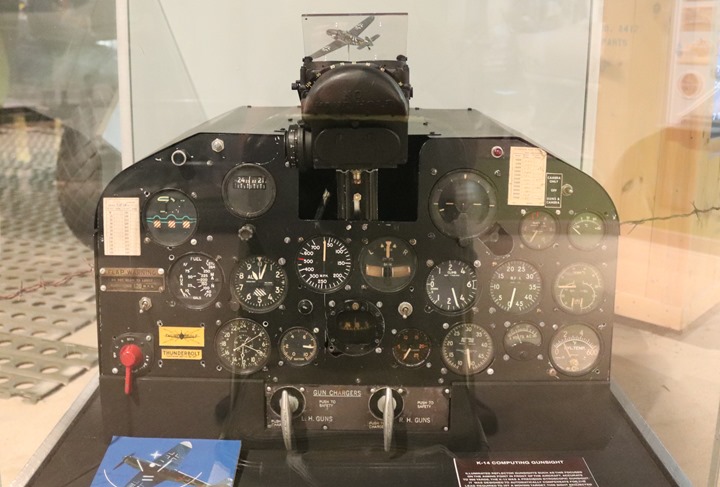
Author's photo added 8-4-2018.

Author's photo added 8-4-2018.

Author's photo added 8-4-2018.

Author's photo added 8-4-2018.

Author's photo added 8-4-2018.

Author's photo added 8-4-2018.
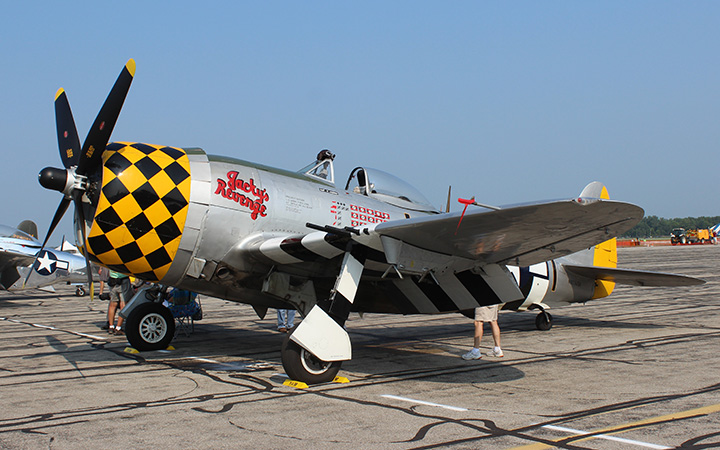
The Republic P-47 Thunderbolt utilized the
K-14B gun sight after September 1944.
Author's photo added 8-4-2018.

The P-51D also utilized the K-14B gun sight
after September 1944. Author's photo.
Oxygen Flow Indicator (Blinker):
"On Two Fronts" describes how AC Spark Plug developed the Oxygen Blinker;
and shows the engineering capability of AC Spark Plug during World War
Two to develop products beyond the normal automotive product line.
This was a very important instrument for bomber crews to verify that
oxygen was flowing at high altitudes. AC Spark Plug did not have
the manufacturing capacity to make the Blinker, so Delco Radio built
the instruments during the war.

At altitudes above 10,000 feet, aircrews in World War Two needed
supplemental
oxygen to stay alive, as the oxygen content thinned out. Each crew
member on an aircraft would have one of these indicators which blinked
when oxygen was flowing. It was an important visual aide, allowing
a crewman to quickly verify
that his all-important oxygen was flowing. Author's photo.

This view, from the bombardier's position on
a B-17 undergoing restoration, shows how the AC Spark Plug-designed
Blinker was part of the crew member's entire oxygen system. AC
Spark Plug produced oxygen pressure gauges, like the one to the right of
the Blinker, and were used in many of the American military aircraft of
World War Two. Author's photo from the Champaign Aviation Museum
in Urbana, OH.
.50 Caliber Machine Gun:
The .50 caliber heavy machine gun was AC Spark Plugs' signature World
War Two product. On September 30, 1940, AC Spark Plug received an
order for 14,741 aircraft flexible and 7,385 heavy barrel .50 caliber
machine guns. By November 1944, AC and three other GM divisions
produced one million machine guns. Between Saginaw Steering Gear
and Frigidaire Divisions of GM, they produced 775,384 Browning machine
guns by war's end. The amount that Brown-Lipe-Chapin built is
unknown but estimated at 100,000. An estimate for the number of .50 caliber Browning machine guns built by AC Spark Plug is 250,000.
The complete story of AC Spark Plug's
manufacture of .50 caliber machine guns is explained in detail in both
"On Two Fronts" and "One Million Browning Machine Guns." There are
links to these two documents at the top and bottom of this page.

This cut-away of .50 caliber Browning
machine gun was found in the maintenance shop of the National Armor and
Cavalry Museum at Fort Benning, GA. Author's photo added
10-7-2018.

Author's photo added 10-7-2018.

Author's photo added 10-7-2018.

The .50 caliber heavy barrel machine gun was
used by all of the services in WWII. Author's photo.

Author's photo.

Author's photo.
Instrument Panels: According
to page 26 of "On Two Fronts," written in October 1943, AC Spark Plug
had 15 different types of instrument panels that were used in tanks,
trucks, submarines, jeeps, and small boats. As the war progressed,
new weapons were introduced that required more and different instrument
panels. This was especially true for armored vehicles, which
included the Buick built M18 Hellcat tank destroyer, Cadillac built M26
Chaffee light tank, and the Fisher Body M26 Pershing heavy tank.

This photo from "On Two Fronts" shows an
instrument panel that would go into either an M4A2 Sherman tank or an M10
Wolverine tank destroyer. Both were powered by twin Detroit Diesel
engines requiring two sets of instruments and switches to operate the
vehicles.
"On Two Fronts" states that AC Spark Plug
instrument panels were used in all Sherman tanks. If so, the GM
Division supplied 49,234 instrument panels for five different types of
Sherman tanks built by ten different companies from the State of
Washington to Pennsylvania.
One thing is certain. AC Spark Plug
supplied instrument panels and other components to other General Motors
Divisions that were building tanks, tank destroyers, and armored cars.
The Fisher Body Tank Arsenal in Grand Blanc, MI was just 5.5 miles south
of the main AC Spark Plug plant on Industrial Ave. in Flint.
During WWII the Grand Blanc Tank Arsenal turned out 19,034 tanks and
tank destroyers with AC Spark Plug components in them.

This M4A2 is the oldest Fisher Body built
tank on display in North America. It is located at Victoria Park in London,
Ontario. It came off the Grand Blanc assembly line in September
1942 equipped with AC Spark Plug parts. It landed with the Canadian Army at
Normandy, and then fought its way across Europe until the end of the
war. It survived its many battles, and then came back to Canada.
Fisher Body Grand Blanc produced 7,508 M4A2 Sherman tanks. Author's
Photo.

This is a cutaway of a Fisher Body Grand
Blanc M4A2 on display at the Canadian War Museum in Ottawa, ONT.
Author's Photo.

The AC Spark Plug instrument panel.
Author's Photo.

Author's Photo.

The M4A2 was powered by two Detroit Diesel
6-71 engines. Author's Photo.

Four of the six AC Spark Plug air filters
can be seen in this photo along with a cutaway of one oil filter.
Author's Photo.

The Grand Blanc-built M10 Wolverine tank
destroyer had the same power train as the M4A2. 4,993 were built
at Grand Blanc. Author's Photo.

Of all of the Sherman Tanks built during World
War Two,
it is noteworthy that a Fisher Body M4A3(75) tank built in Grand Blanc,
MI has the honor of representing all of the M4s that participated in
the Battle of the Bulge. Registration Number 3081532 was one
of 339 M4A3 Sherman tanks built in the Fisher Body Tank Arsenal in Grand
Blanc, MI in March 1944. It has an AC Spark Plug instrument panel.
The engine is a Ford built 500 hp V-8 which would have Ford components
in the engine bay. Author's photo.

Buick was located near AC's main plant on
Industrial Avenue. Buick built 2,507 M18 Hellcats with AC Spark
Plug instrument panels installed. Author's photo.

"On Two Fronts" states that AC Spark Plug
instrument panels were used in all M5 and M5A1 Stuart light tanks.
If so, then, AC Spark Plug supplied instrument panels for 6,810 M5
series tanks built by the Cadillac and Southern California Divisions of
GM, and Massey Harris. Each tank had two Cadillac V-8 engines that
would have AC air, fuel, and oil filters.
This Cadillac-built M5 came off the assembly
line in September 1942. Author's photo from the First Division
Museum in Wheaton, IL.

After M5 production halted, Cadillac and
Massy Harris built 4,731 M24 Chaffee light tanks powered by twin
Cadillac V-8 engines equipped with AC Spark Plug components.
Author's photo from the First Division Museum in Wheaton, IL.
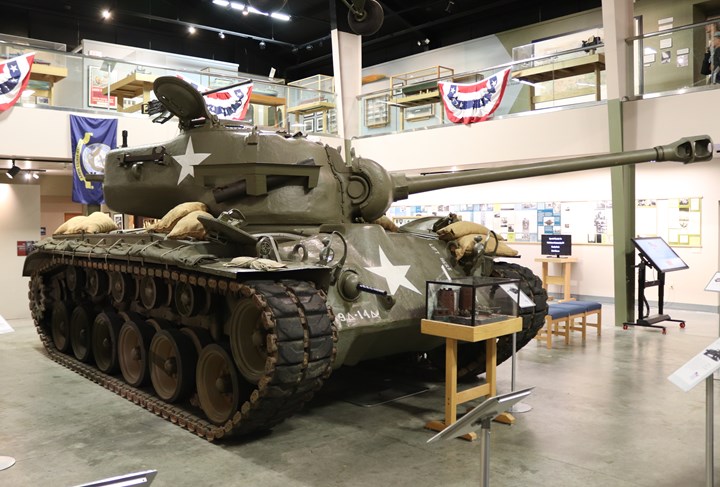
Fisher Body and Chrysler built 2,202 M26
Pershing heavy tanks from 1944 through 1945. Each one had an instrument
panel built by AC Spark Plug. This particular Fisher Body M26 was
at the Battle for the Remagen Bridge on the Rhine River in March 1945.
Author's photo from the Wright Museum of WWII in Wolfeboro, NH.

Chevrolet was also located near AC's main
plant on Industrial Avenue. Chevrolet built 3,844 Staghound
armored cars for the United Kingdom. Along with the AC instrument
panels, the division also supplied the fuel, air and oil filters for the
two GMC 6-cylinder engines that powered the Staghound. Author's
photo from the Canadian War Museum in Ottawa, ONT.

GMC and Chevrolet built 528,829 2-1/2 ton
6x6 trucks with the GMC nameplate on it. Author's photo.

Seen here is one of the 528,829 AC Spark
Plug instrument panels that were installed in the GMC trucks. AC
Spark Plug also supplied 528,829 oil, air, and fuel filters for the GMC
inline six engines. Author's photo.

GMC and Chevrolet built
21,147 2-1/2 ton 6x6 amphibious trucks DUKWs with the GMC nameplate on
them. Author's photo.

It was built with AC instrument panels, and
oil, air, and fuel filters. Author's photo.

"On Two Fronts" mentions instrument panels
used in submarines. This panel was for the four engines built by
Cleveland Diesel Division of GM, which powered 136 American submarines
during WWII. This is the USS Cod in Cleveland, OH. Author's
photo.
Below are links to "On Two Fronts" and "One
Million Browning Machine Guns." Both give excellent detail on
operations at AC Spark Plug during WWII.

On Two
Fronts

One
Million Browning Machine Guns
|



















































































